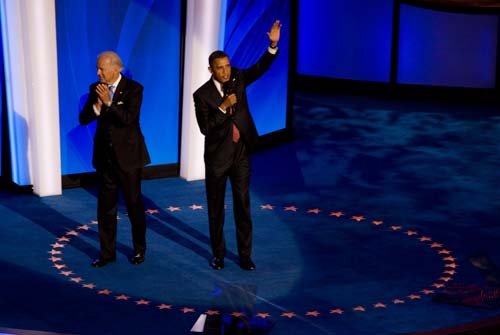Step-by-Step on the Campaign Trail

How the President Gets Elected
Don't know the difference between a caucus and a convention? Unsure what the electoral college is? Check out our handy guide to the seven steps of the presidential election.
Candidate announces plan to run for office.
This announcement launches the candidate's official campaign. Speeches, debates, and baby-kissing begin in full force.
Candidate campaigns to win delegate support.
The first stage of a presidential campaign is the nomination campaign. At this time the candidate is competing with other candidates in the same party, hoping to get the party's nomination. The candidate works to win delegates—representatives who pledge to support the candidate's nomination at the national party convention—and to persuade potential voters in general.
Caucuses and primary elections take place in the states.
Caucuses and primaries are ways for the general public to take part in nominating presidential candidates. Before the 20th century , only the party leaders in each state could nominate presidential candidates.
At a caucus, local party members gather to nominate a candidate. A caucus is a lively event at which party leaders and activists debate issues, consider candidates, choose delegates, and discuss the party platform, or statement of principles. The rules governing caucus procedures vary by party and b y state.
A primary is more like a general election. Voters go to the polls to cast their votes for a presidential candidate (or delegates who will represent that candidate at the party convention). Primary elections are the main way for voters to choose a nominee.
Nominee for president is announced at national party conventions.
The main goal of a national party convention is to unify party members behind the party's platform and nominees. Thousands of delegates gather to rally support for the platform and to nominate candidates for president and vice-president.
From the 1820s until the 1930s, party conventions were boisterous events in which determining a nominee could spark hot debate. By the mid-20th century, however, primary elections had become the main way of selecting a nominee.
After the convention, the second stage of the presidential campaign begins: the election campaign. In this stage, presidential candidates from different parties compete against each other.

Barack Obama and Joe Biden at the 2008 Democratic National Convention. Photo by Carol M. Highsmith
Citizens cast their votes.
Presidential elections are held every four years on the Tuesday after the first Monday of November. This was decided long ago, when many voters had to make a long, slow journey to the polling place. By early November crops were in but the weather was usually not too cold for travel. And because Sunday was a day of rest, voters would begin the trip on Monday.
Many Americans think that when they cast their ballot, they are voting for their chosen candidate. In actuality they are selecting groups of electors in the electoral college.
The electoral college casts its votes.
Some of the founding fathers wanted Congress to elect the president. Others wanted the president to be elected by popular vote. The electoral college represents a compromise between these ideas.
Every state has a number of electors equal to its number of congresspersons. In addition, there are three electors for the District of Columbia. At the last presidential election there were 538 electors. Although laws vary by state, electors are usually chosen by popular vote. An elector may not be a senator, representative, or other person holding a U.S. office.
All the electoral votes from a particular state go to the candidate who leads the popular vote in that state. A candidate can therefore win millions of popular votes but no electoral votes. This “winner takes all” system can produce seemingly uneven results; in the elections of 1876, 1888, and 2000, for instance, the candidate who had the greatest popular vote did not win the greatest electoral college vote, and so lost the presidency.
On the first Monday after the second Wednesday in December, the electors cast their ballots. Nothing in the Constitution or federal law requires that the electors vote along with their state's popular vote, though an elector who did not would likely not be reelected. At least 270 electoral votes are required to elect a president. If this majority is not reached, the House of Representatives will elect the president.
The president is inaugurated.
On January 20, the president enters office in a formal ceremony know as the inauguration. He takes the presidential oath: “I do solemnly swear (or affirm) that I will faithfully execute the office of President of the United States, and will to the best of my ability, preserve, protect, and defend the Constitution of the United States.”
In accordance with the Constitution, the inauguration used to take place on March 4, because transportation and communication were so slow that it took time to collect election results and allow winning candidates to travel to Washington, D.C. With the 20th Amendment in 1933, however, the inauguration date was changed to January 20.







